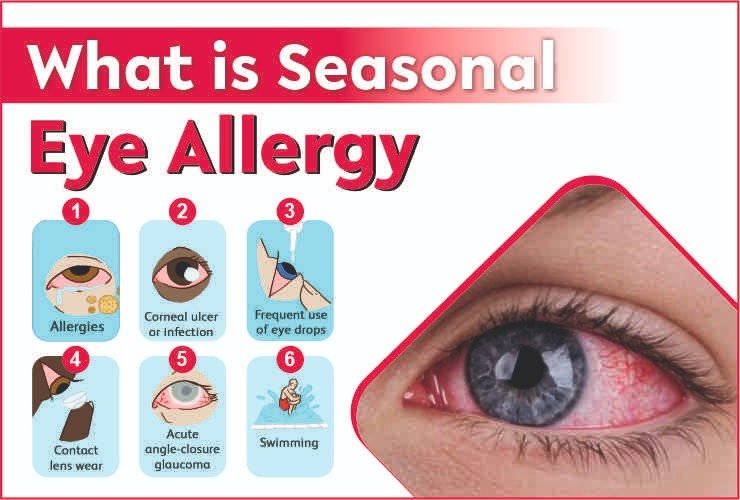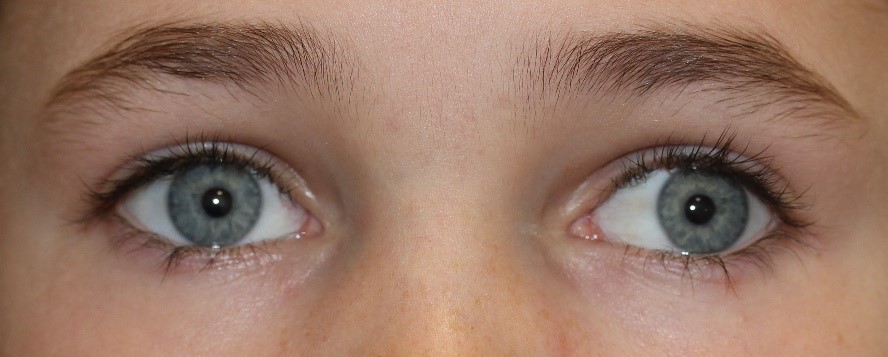Allergic conjunctivitis is inflammation of the conjunctiva (the membrane covering the white part of the eye) due to allergy. Although allergens differ between patients, the most common cause is hay fever. Symptoms consist of redness (mainly due to vasodilation of the peripheral small blood vessels), oedema (swelling) of the conjunctiva, itching and increased lacrimation (production of tears). If this is combined with rhinitis, the condition is termed allergic rhinoconjunctivitis.
Allergic conjunctivitis occurs when the conjunctiva becomes swollen or inflamed due to a reaction to pollen, dust mites, pet dander, mold, or other allergy-causing substances.
The symptoms are due to release of histamine and other active substances by mast cells, which stimulate dilation of blood vessels, irritate nerve endings and increase secretion of tears.
Treatment of allergic conjunctivitis is by avoiding the allergen (e.g. avoiding grass in bloom during the "hay fever season") and treatment with antihistamines, either topical (in the form of eye drops), or systemic (in the form of tablets). Antihistamines, medication that stabilizes mast cells, and non-steroidal anti-inflammatory drugs (NSAIDs) are safe and usually effective.

Causes eResearch by Navid Ajamin -- winter 2013
The cause of allergic conjunctivitis is an allergic reaction of the body's immune system to an allergen. Allergic conjunctivitis is common in people who have other signs of allergic disease such as hay fever, asthma and eczema.
Among the most common allergens that cause conjunctivitis are:
Pollen from trees, grass and ragweed
Animal skin and secretions such as saliva
Perfumes
Cosmetics
Skin medicines
Air pollution
Smoke
Dust mites
Eye drops
Most cases of seasonal conjunctivitis are due to pollen and occur in the hay fever season, grass pollens in early summer and various other pollens and moulds may cause symptoms later in the summer.
Perennial conjunctivitis is commonly due to an allergy to house dust mite (a tiny insect-like creature that lives in every home).
Giant papillary conjunctivitis is a very rare condition that is mainly caused by an allergic reaction to "debris". Surgery may also cause this type of allergic conjunctivitis.
Contact dermatoconjunctivitis is caused by the rest of the allergens that conjunctiva may come into contact with: cosmetics, medications and so on.
Symptoms
Symptoms may be seasonal and can include:
- Intense itching or burning eyes
- Puffy eyelids, most often in the morning
- Red eyes
- Stringy eye discharge
- Tearing (watery eyes)
- Widened blood vessels in the clear tissue covering the white of the eye
Exams and Tests
Your health care provider may look for the following:
- Small, raised bumps on the inside of the eyelids (papillary conjunctivitis)
- Positive skin test for suspected allergens on allergy tests
Allergy testing may reveal the pollen or other substances that trigger your symptoms.
- Skin testing is the most common method of allergy testing.
- Skin testing is more likely to be done if symptoms do not respond to treatment.
Treatment

The best treatment is to avoid what causes your allergy symptoms as much as possible. Common triggers to avoid include dust, mold and pollen.
Some things you can do to ease symptoms are:
- Use lubricating eye drops.
- Apply cool compresses to the eyes.
- Do not smoke and avoid secondhand smoke.
- Take over-the-counter oral antihistamines or antihistamine or decongestant eye drops. These medicines can offer more relief, but they can sometimes make your eyes dry. (Do not use the eye drops if you have contact lenses in place. Also, do not use the eye drops for more than 5 days, as rebound congestion can occur).
If home-care does not help, you may need to see a provider for treatments such as eye drops that contain antihistamines or eye drops that reduce swelling.
Mild eye steroid drops can be prescribed for more severe reactions. You may also use eye drops that prevent a type of white blood cell called mast cells from causing swelling. These drops are given along with antihistamines. These medicines work best if you take them before you come in contact with the allergen. Referral to an ophthalmologist before using steroid eye drops should be done since intraocular pressure measurements and a more thorough eye exam (using a slit lamp) is needed.

Reference:
- en.wikipedia.org/wiki/Allergic_conjunctivitis
- Causes of eye allergies | drkashishgupta.com/- Bathinda India
- Allergic conjunctivitis Information | mountsinai.org/ Mount Sinai - New York
See Also:
What Is Allergic Conjunctivitis? What Causes Allergic Conjunctivitis? medicalnewstoday.com
How to cope with the spring conjunctivitis? eyejournal.net
Vernal keratoconjunctivitis wikipedia.org








 وبلاگ تخصصی عینک شامل مجموعه مطالب پزشکی است که اطلاعات مفیدی در رابطه با عینک , چشم، لنز، سلامتی چشم و راه های پیشگیری از بیماریهای چشمی، کنترل و درمان آن را در اختیار شما کاربر محترم می گزارد.
وبلاگ تخصصی عینک شامل مجموعه مطالب پزشکی است که اطلاعات مفیدی در رابطه با عینک , چشم، لنز، سلامتی چشم و راه های پیشگیری از بیماریهای چشمی، کنترل و درمان آن را در اختیار شما کاربر محترم می گزارد.